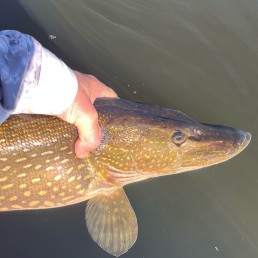Fall: A Big Pike Prison Break?
SHARE THIS POST
Fall pike fishing can essentially be thought of as spring in reverse. Let me explain, including some significant distinctions to keep in mind…
• Waters consistently cool down starting in September, if not late August. On most waters, pike gradually shift locations back toward late-spring areas. Unlike spring, though, weeds are fully developed at the start of fall, so the transition can be simply moving shallower on prime, main-lake areas as well, such as large points with broad food shelves.
• Since spawning is not a factor, transition back to prime spring locations, like bays with the best features, usually does not include moving all the way into spawning locations. However, significant moves, at least partway up forage-rich tributaries or boat channels on well-developed lakes, can occur.
• Whereas weeds are advancing in spring, they are declining in fall, starting by mid-fall if not before. Targeting them, therefore, shifts toward finding the best remaining green weeds as opposed to the best, or only, emerging weeds in spring.
• Gradually lowering water temperatures, like slowly warming temps in spring, are natural to the pike’s ecosystem, and result in consistently good activity. Unlike spring, though, sharp, even major cold fronts can be very good in fall. Even welcome, it seems, including the first big cold fronts in September and October bringing a significant spike in action for better pike.
Overall, fall locations and presentations are similar to spring; and like spring, it’s important to recognize a separation between early and later patterns in the autumn period. Basically, early fall is similar to late spring, and late fall has similarities to early spring, especially in water temperatures; but spawning not being a factor in fall changes the strategy some.
Are you enjoying this post?
You can be among the first to get the latest info on where to go, what to use and how to use it!
A couple of things to keep in mind when pike fishing in the fall:
Baits should center on covering water with weed cover; spinnerbaits, in-lines, then bigger and deeper versions may bring better quality fish. Floating, shallow jerkbait lures are used for slow-trolling modest flat and edge depths, and a less common jig-and-crankbait combo gets bonus fish when activity slows.
Cold fronts are natural and helpful in fall; clouds and wind also tend to help bring a good bite, like most of the rest of the year, but probably even better in fall.
If you want to try a different, exciting fish species or technique, you’ll find plenty of suggestions in every issue of MidWest Outdoors. Subscribe on our website.
MWO
SHARE THIS POST
You may also like...
Nothing found.
Did you enjoy this post?
You can be among the first to get the latest info on where to go, what to use and how to use it!
